英语论文选题与谋篇作业例样
- 格式:doc
- 大小:38.00 KB
- 文档页数:4
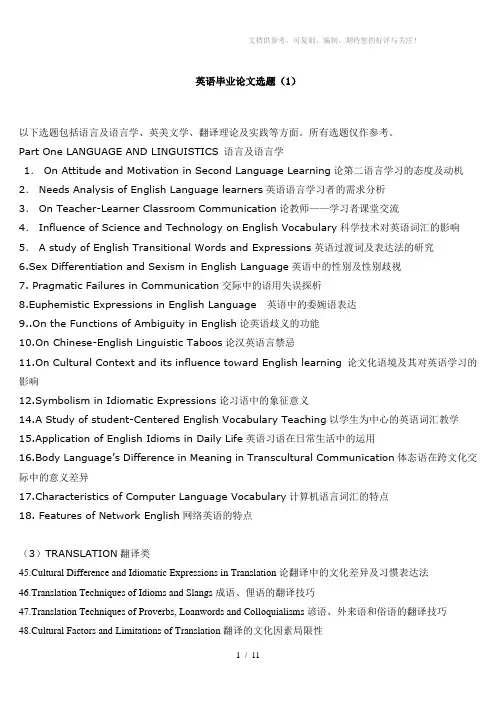
英语毕业论文选题(1)以下选题包括语言及语言学、英美文学、翻译理论及实践等方面。
所有选题仅作参考。
Part One LANGUAGE AND LINGUISTICS 语言及语言学1. On Attitude and Motivation in Second Language Learning论第二语言学习的态度及动机2. Needs Analysis of English Language learners英语语言学习者的需求分析3. On Teacher-Learner Classroom Communication论教师——学习者课堂交流4. Influence of Science and Technology on English Vocabulary科学技术对英语词汇的影响5. A study of English Transitional Words and Expressions英语过渡词及表达法的研究6.Sex Differentiation and Sexism in English Language英语中的性别及性别歧视7. Pragmatic Failures in Communication交际中的语用失误探析8.Euphemistic Expressions in English Language 英语中的委婉语表达9..On the Functions of Ambiguity in English论英语歧义的功能10.On Chinese-English Linguistic Taboos论汉英语言禁忌11.On Cultural Context and its influence toward English learning 论文化语境及其对英语学习的影响12.Symbolism in Idiomatic Expressions论习语中的象征意义14.A Study of student-Centered English Vocabulary Teaching以学生为中心的英语词汇教学15.Application of English Idioms in Daily Life英语习语在日常生活中的运用16.Body Language’s Difference in Meaning in Transcultural Commun ication体态语在跨文化交际中的意义差异17.Characteristics of Computer Language Vocabulary计算机语言词汇的特点18. Features of Network English网络英语的特点(3)TRANSLATION翻译类45.Cultural Difference and Idiomatic Expressions in Translation论翻译中的文化差异及习惯表达法46.Translation Techniques of Idioms and Slangs成语、俚语的翻译技巧47.Translation Techniques of Proverbs, Loanwords and Colloquialisms谚语、外来语和俗语的翻译技巧48.Cultural Factors and Limitations of Translation翻译的文化因素局限性49.On Translation of Trademarks in Ads and Names of Export Commodities论广告商标、出口商品名称的翻译50.On Translation of Tourist Guide论旅游指南的翻译51.On Translation of Computer Terms论计算机的术语翻译52.On the Writing and Translation of Foreign Trade contracts论涉外经济合同写作及翻译53.On Equivalent Translation and Its Application in E-C Translation论等效翻译及其在英汉翻译中的应用54Lexical Gaps in Translation 英汉互译的词义差异55.Translation of Rhetoric Devices in EST科技英语修辞手法的翻译56.On “Negation”论正说反译、反说正译新闻英语的特点及其翻译网络英语及其翻译浅谈国际商务合同的翻译计算机英语的特点及翻译论中国古诗词的英文翻译广告英语的词汇特征与翻译浅谈汉诗英译的几个难点英文歌词翻译浅析文化差异与翻译文体学和翻译论商务英语翻译原则初涉外事口译的特点及翻译技巧外交会议中的口译错误现象及应对广播电视中的翻译艺术英汉称谓语的比较及翻译英汉成语跨文化研究与翻译策略指环王及欧洲奇幻文学专有名词翻译浅析翻译中的语境问题对英汉互译中标点符号转换的一些看法传统美国圣诞节和中国汉族春节的比较从服饰看中西文化差异浅谈中西方的茶文化中美友谊异同点于跨文化交际中西方文化中礼貌原则之差异及原因分析中西交际风格的差异浅谈东西方宗教文化之差异论英汉颜色词的文化差异探究汉英色彩词文化差异的根源英汉文化差异对颜色词翻译的影响从颜色词看英汉互译中的文化忠实与文化转化浅析颜色词的语义特征中西文化差异对商务谈判的影响中西思维方式差异的成因及表现形式从习语看中西文化差异中西言语禁忌对比中西方禁忌习俗比较从李阳的“疯狂英语”探讨英语教学中的情感因素浅谈学生口语交际能力的培养焦虑对大学生英语学习的影响及对策小学英语课堂的互动教学试论背诵对英语学习的作用浅谈英语教学语言中西教师在课堂教学中的体态语差别少儿英语课堂中的奖励和惩罚中世纪基督教文化和资本主义的兴起英语的汉化现象英语的双关语词汇探源浅谈非言语交际从中西饮食文化差异人和西方人论语言表达上东方的含蓄和西方的直白动物习语在英汉中的文化内涵与差异习语映射出的英汉文化差异中西方语言中委婉语的比较中西文化数字的性质、涵义之比较英汉文化词的对比研究中西方广告语的文化比较非语言行为在跨文化交际中的意义上的差异达到成功跨文化交际的几个要素试析美国的新闻娱乐化论美国的“天赋使命”观与文化输出战略中美教育差异谈中学生英语学习错误分析小议交互式语言教学谈英语教学中的目的语文化和母语文化教学建构主义理论对英语教学的指导意义中学英语口语教学如何调动学生学习英语的积极性浅谈英语教学中对后进生的转化如何活跃英语课堂的气氛论中学英语潜能教育计算机辅助英语教学的思考网络教育的优劣与发展前景心理语言学对于外语学习心理的启示高中英语课堂提问的艺术和科学性性格差异:英语学习和教学中不可忽视的问题如何培养内向型学生的英语自主学习能力母语在英语学习中的迁移作用小组讨论在大学英语口语教学中的实践意义全身反应法和整体语言法在儿童英语教学中的互补作用论交际法在外语教学中的应用中学英语教学和文化导入汉英翻译中的文化电影剧本与片名的翻译电影片名的翻译中式菜肴名称的英译问题英语人名的起源及翻译文化领域中商标词的翻译语言与文化——抽象名词的翻译文化翻译中异域文化处理原则及方法试论英语成对词的深层结构及其翻译从文化差异的角度看汉英颜色的使用及互译英汉数字成语的比较和翻译论谓语动词的翻译广告中的翻译和技巧译者的文化背景对翻译作品的影响英语中的禁忌语B1 语言与语言学类B1—001 从历史文化的发展看某个英语词或短语的语义演变B1—002 英诗中常用的修辞B1—003 英语谚语的修辞手法B1—004 委婉语种种B1—005 英语中的缩略语B1—006 英语词汇中的外来语单词B1—007 英语新词新意探究B1—008 美国英语的特色B1—009 如何正确把握英语定语从句(或其他各种从句或语法形式)在句子中的确切含义B2 语言教学类B2—001 扩大词汇量和提高英语阅读能力的关系B2—002 提高英语阅读速度的主要障碍B2—003 英语阅读能力和阅读速度的关系B2—004 通过扩大知识面提高英语阅读能力B2—005 如何在阅读实践中提高英语阅读能力B2—006 阅读英文报刊的好处B2—007 如何处理精读和泛读的关系B2—008 如何对付英语阅读材料中的生词B2—009 如何通过阅读扩大词汇量B2—010 提高阅读能力和提高英语听力的关系B2—011 英语听说读写四种技能的关系B2—012 通过英语阅读提高英语写作能力B2—013 英语快速阅读能力的构成成分B2—014 中学生英语自主学习能力的培养B2—015 英语教学中的语言焦虑及解决策略B2—016 简笔画—英语教学中简单高效的教学手段B2—017 提高英语听力理解能力的策略和技巧B2—018 电子辞典与英语教学B2—019 普通话对英语语音的迁移作用B2—020 母语迁移在基础教育各阶段中的作用B2—021 提高大班课堂教学的效果B2—022 《英语课程标准》研究B2—023 口语教学中教师的角色B2—024 从心理学角度探讨少儿英语教学B2—025 英语课堂提问的策略研究B2—026 英语后进生产生的原因以及补差方法研究B2—027 英语词汇教学方法探讨B2—028 小学生英语口语能力评估方法研究B2—029 朗读在英语教学中的作用B2—030 任务型教学法研究B2—031 方言对学生英语语音的影响B2—032 英语阅读课堂教学模式探讨B2—033 英语课堂的合作学习策略研究B2—034 中学生英语学习策略的培养B2—035 探究式教学法在中学英语教学中的应用B2—036 现代信息技术在英语教学中的应用B2—037 教师教学行为对高中生英语学习的影响B2—038 实施成功教育减少两极分化B2—039 小学英语活动课教学模式研究B2—040 中学英语听力训练最佳方案B2—041 原版电影与英语学习B2—042 中学生英语兴趣的培养B2—043 《疯狂英语》(或各种教学方式)的利与弊B2—044 张思中教学法实践调查报告B2—045 如何杜绝中式英语B2—046 英语教师的文化素养B2—047 网络时代如何学好英语B2—048 背景知识与阅读理解B2—049 上下文在阅读理解中的作用B2—050 家庭教师在中学生英语学习中的利弊B2—051 中学英语教学现状分析B2—052 中学英语课堂上的Daily ReportB2—053 中外教师解释课文方法比较B2—054 中外教师课堂提问方法比较B2—055 中外教师课堂鼓励性用语比较B2—056 中外教师对学生总体要求之比较B2—057 计算机辅助英语教学中的诸问题B2—058 不同种类的计算机辅助英语教学方式B2—059 计算机辅助英语教学中的教学法原则B3 翻译类B3—001 英汉文化差异和翻译B3—002 英语习语翻译B3—003 翻译与语境B3—004 翻译中的对等问题B3—005 翻译中的衔接与连贯B3—006 翻译中的文化信息传递B3—007 语篇体裁与翻译策略B3—008 汉语四字词语的翻译B3—009 数字的翻译B3—010 翻译中的语序转换B3—011 谈英语被动句的翻译B3—012 英汉句法对比和翻译B4 文学类B4—001 文学批评方法之我见B4—002 解读布莱克诗篇《老虎》的象征意义B4—003 弥尔顿创作目的和结果的矛盾之我见B4—004 华滋华斯诗歌的自然观B4—005 简析《秋颂》的美学价值B4—006 由《云雀颂》看雪莱的诗歌创作观B4—007 论叶芝诗歌中的象征主义B4—008 狄金森诗歌的现实意义B4—009 论现代诗歌与后现代诗歌的异同B4—010 解读《麦克白》的创作意义B4—011 由海明威的《杀人者》理解客观叙述法B4—012 解读福克纳的《干燥七月》B4—013 中外文学作品比较B4—014 不同英语文作品比较B4—015 英文作品中的人物分析B4—016 英文作品的社会意义B4—017 英文作品的文体风格参考文献除相关的专著之外,以下杂志的现刊与过刊可供参考:《中国翻译》,《上海科技翻译》,《外语教学与研究》,《外国语》,《中小学外语教学》,《外语电化教学》,《中小学英语教学与研究》,《外国文学评论》,《福建外语》,《外语界》,《国外外语教学》,《现代外语》及外语院校学报等I.中学英语教学:1.中学英语词汇教学初探2.中学英语教学中的“文化”因素3.浅议把英语释义引进中学课文教学4.浅谈听、说、读、写能力的培养5.中学英语教学中应注重学生能力的培养6.游戏在中学英语教学中的作用7.谈谈在英语教学中的情景教学8.身势语在英语教学中的应用9.在英语教学中开发学生的非智力因素10.浅谈怎样用英语组织课堂教学11.如何提高差生的阅读水平12.“角色表演”在课堂教学中的应用13.课外活动的设计与指导14.英语教学中的德育渗透15.电化教学在英语教学中的地位16.英语课堂教学中怎样激发学生兴趣17.中学英语句型教学18.中学教学中如何提高听的能力19.“任务型”教学模式探讨20.音乐在英语教学中的应用21.影响阅读理解的因素分析22.浅谈中学生阅读理解能力的培养23.如何培养和提高学生的英语交际能力24.如何提高中学生的英语写作能力25.母语对中学生学习英语的影响26.英语教学中如何引导学生培养语感27.论文化背景知识在阅读教学中的作用28.文化差异对听力理解的影响29.浅谈中学生英语口语能力的培养30.浅谈中学英语教学中学生学习兴趣的培养II.语言学1.英语中“将来时”表达法初探2.试谈“颜色词”在英语中的使用3.英语中的性别语言现象探索4.英语委婉语的语言特点及文化内涵5.跨文化交际中的语用差异6.反意疑问句的特殊句型7.运用构词法记忆英语单词8.英语中“死亡”委婉语文化因素剖析9.英语学习中的母语负迁移现象探索10.语义模糊与交际11.英汉语言形式与思维方式对比12.中英文化差异在语言中的反映13.英语中主动形式表被动意义14.汉英数量词的文化差异15.英语广告标题的修辞特点文档供参考,可复制、编制,期待您的好评与关注!16.浅谈英汉词语的文化内涵17.论英汉词义的不对应性III.翻译1.谈英语谚语的翻译2.谈英语幽默的翻译3.英语汉译技巧初探4.翻译中常见错误分析5.中英思维方式的差异对翻译的影响6.会话含义的推导与翻译7.词汇的文化内涵与翻译8.语境在翻译中的作用9.翻译技巧探索10.商标词翻译11.广告语言的翻译12.论英汉互译中的语义等值问题13.英汉文化差异对翻译的影响14.英汉谚语的理解和翻译15.浅谈颜色词在英语中的翻译16.中西文化差异与翻译障碍17.英语比喻性词语中文化内涵及翻译18.英语意义否定表现法及其汉译19.浅谈新闻标题的翻译温馨提示-专业文档供参考,请仔细阅读后下载,最好找专业人士审核后使用!11 / 11。
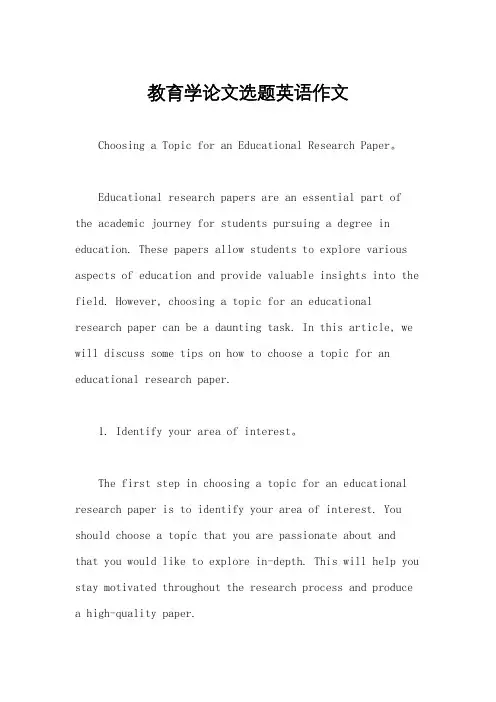
教育学论文选题英语作文Choosing a Topic for an Educational Research Paper。
Educational research papers are an essential part of the academic journey for students pursuing a degree in education. These papers allow students to explore various aspects of education and provide valuable insights into the field. However, choosing a topic for an educational research paper can be a daunting task. In this article, we will discuss some tips on how to choose a topic for an educational research paper.1. Identify your area of interest。
The first step in choosing a topic for an educational research paper is to identify your area of interest. You should choose a topic that you are passionate about andthat you would like to explore in-depth. This will help you stay motivated throughout the research process and produce a high-quality paper.2. Research current educational issues。
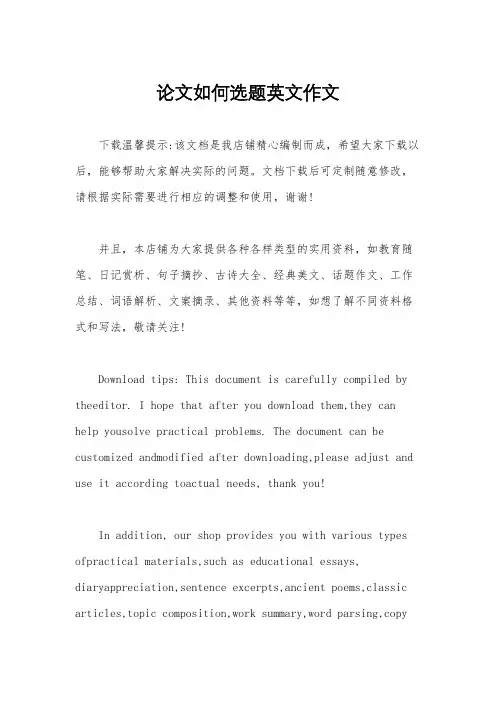
论文如何选题英文作文下载温馨提示:该文档是我店铺精心编制而成,希望大家下载以后,能够帮助大家解决实际的问题。
文档下载后可定制随意修改,请根据实际需要进行相应的调整和使用,谢谢!并且,本店铺为大家提供各种各样类型的实用资料,如教育随笔、日记赏析、句子摘抄、古诗大全、经典美文、话题作文、工作总结、词语解析、文案摘录、其他资料等等,如想了解不同资料格式和写法,敬请关注!Download tips: This document is carefully compiled by theeditor. I hope that after you download them,they can help yousolve practical problems. The document can be customized andmodified after downloading,please adjust and use it according toactual needs, thank you!In addition, our shop provides you with various types ofpractical materials,such as educational essays, diaryappreciation,sentence excerpts,ancient poems,classic articles,topic composition,work summary,word parsing,copyexcerpts,other materials and so on,want to know different data formats andwriting methods,please pay attention!Well, choosing a topic for a paper can be really confusing. You might think about something that really interests you, like your favorite hobby or a movie you love. That way, you'll be more motivated to write about it.Or maybe you could look at what's trendy or popularright now. Something that everyone's talking about. That could make your paper more relevant and interesting.Another option is to go for a topic that you know a lot about already. It'll be easier to research and write.You could also think about a problem that needs to be solved and explore ways to fix it in your paper.Sometimes, a random idea that just pops into your head can turn out to be a great topic. Just go with it and see where it takes you.。
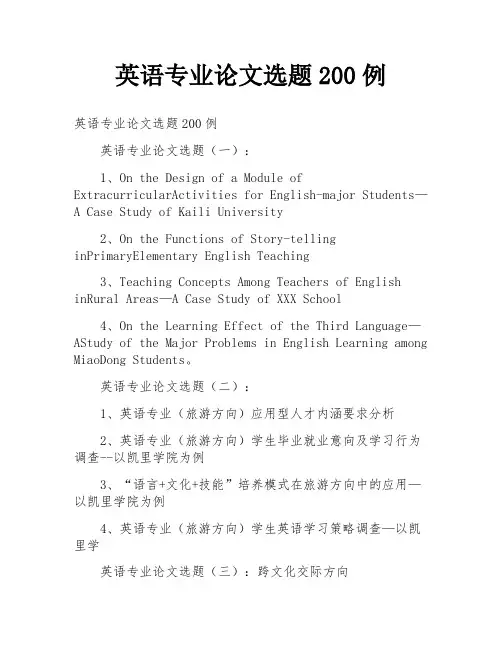
英语专业论文选题200例英语专业论文选题200例英语专业论文选题(一):1、On the Design of a Module of ExtracurricularActivities for English-major Students—A Case Study of Kaili University2、On the Functions of Story-telling inPrimaryElementary English Teaching3、Teaching Concepts Among Teachers of English inRural Areas—A Case Study of XXX School4、On the Learning Effect of the Third Language—AStudy of the Major Problems in English Learning among MiaoDong Students。
英语专业论文选题(二):1、英语专业(旅游方向)应用型人才内涵要求分析2、英语专业(旅游方向)学生毕业就业意向及学习行为调查--以凯里学院为例3、“语言+文化+技能”培养模式在旅游方向中的应用—以凯里学院为例4、英语专业(旅游方向)学生英语学习策略调查—以凯里学英语专业论文选题(三):跨文化交际方向1、。
A Contrastive Study of Western and Chinese Traditional Wedding Customs2、。
The Discrepancy of Chinese and Western Culture in Advertisement3、。
General Features of Language in Postmodern Culture4、。
On the Cultural Implications of Body Language5、。
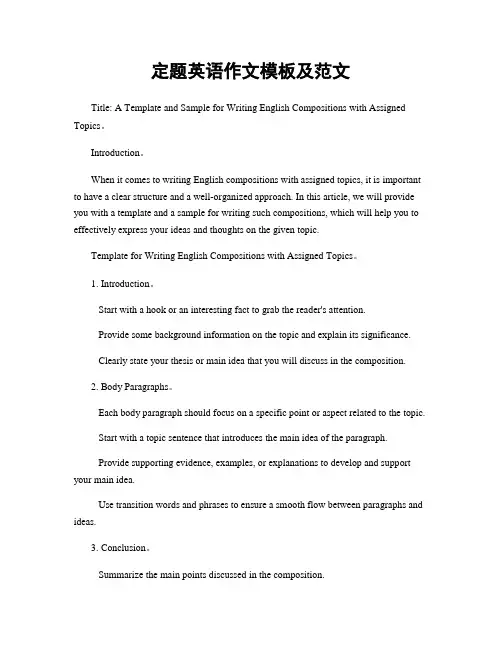
定题英语作文模板及范文Title: A Template and Sample for Writing English Compositions with Assigned Topics。
Introduction。
When it comes to writing English compositions with assigned topics, it is important to have a clear structure and a well-organized approach. In this article, we will provide you with a template and a sample for writing such compositions, which will help you to effectively express your ideas and thoughts on the given topic.Template for Writing English Compositions with Assigned Topics。
1. Introduction。
Start with a hook or an interesting fact to grab the reader's attention.Provide some background information on the topic and explain its significance.Clearly state your thesis or main idea that you will discuss in the composition.2. Body Paragraphs。
Each body paragraph should focus on a specific point or aspect related to the topic.Start with a topic sentence that introduces the main idea of the paragraph.Provide supporting evidence, examples, or explanations to develop and support your main idea.Use transition words and phrases to ensure a smooth flow between paragraphs and ideas.3. Conclusion。
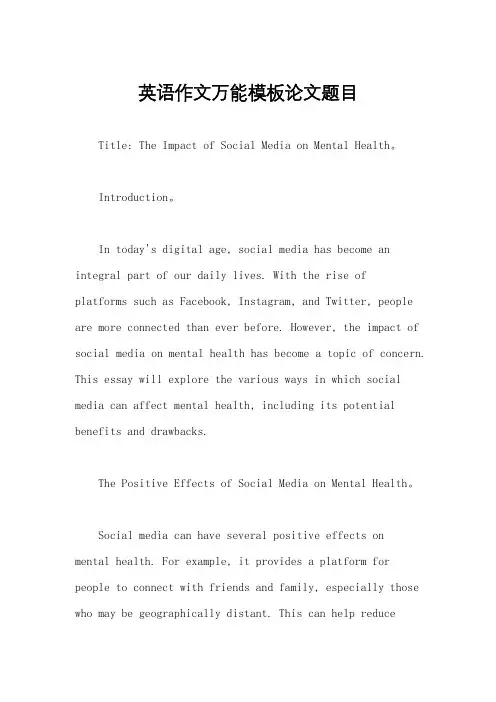
英语作文万能模板论文题目Title: The Impact of Social Media on Mental Health。
Introduction。
In today's digital age, social media has become an integral part of our daily lives. With the rise ofplatforms such as Facebook, Instagram, and Twitter, people are more connected than ever before. However, the impact of social media on mental health has become a topic of concern. This essay will explore the various ways in which social media can affect mental health, including its potential benefits and drawbacks.The Positive Effects of Social Media on Mental Health。
Social media can have several positive effects onmental health. For example, it provides a platform for people to connect with friends and family, especially those who may be geographically distant. This can help reducefeelings of loneliness and isolation, which are known risk factors for mental health issues. Additionally, social media can also be a source of support and encouragement, as people can share their experiences and seek advice from others who may have similar struggles.Furthermore, social media can also be a tool forraising awareness about mental health issues and promoting mental wellness. Many organizations and individuals use social media to share information, resources, and support for those struggling with mental health challenges. This can help reduce stigma and increase access to mental health services for those in need.The Negative Effects of Social Media on Mental Health。
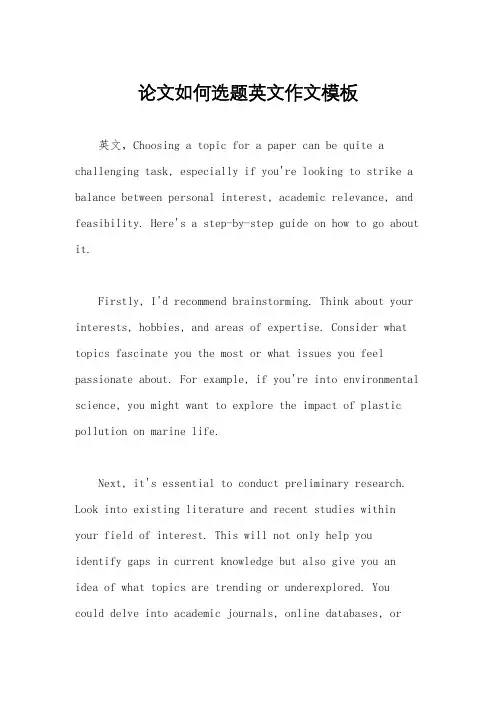
论文如何选题英文作文模板英文,Choosing a topic for a paper can be quite a challenging task, especially if you're looking to strike a balance between personal interest, academic relevance, and feasibility. Here's a step-by-step guide on how to go about it.Firstly, I'd recommend brainstorming. Think about your interests, hobbies, and areas of expertise. Consider what topics fascinate you the most or what issues you feel passionate about. For example, if you're into environmental science, you might want to explore the impact of plastic pollution on marine life.Next, it's essential to conduct preliminary research. Look into existing literature and recent studies within your field of interest. This will not only help youidentify gaps in current knowledge but also give you an idea of what topics are trending or underexplored. You could delve into academic journals, online databases, oreven consult with professors or experts in the field.Once you have a list of potential topics, it's time to narrow it down. Consider factors such as the scope of the topic, the availability of resources, and the time constraints. It's crucial to choose a topic that is neither too broad nor too narrow. For instance, instead of examining "Climate Change," which is vast and complex, you might focus on a specific aspect like "The Impact of Deforestation on Climate Change in the Amazon Rainforest."Furthermore, think about the significance of the topic. Ask yourself, why is this research important? How does it contribute to the existing body of knowledge? A relevant and meaningful topic is more likely to capture the interest of your readers and make a valuable contribution to your field.Another consideration is your own expertise and skills. Choose a topic that aligns with your strengths andinterests but also challenges you to learn and grow. Don't shy away from topics that are slightly outside your comfortzone; they can lead to personal and academic growth.Lastly, don't forget to consider the audience for your paper. Will it be read by academics, professionals, or the general public? Tailor your topic accordingly and ensurethat it's accessible and engaging to your target audience.In conclusion, selecting a topic for your paperrequires careful consideration and research. By brainstorming, conducting preliminary research, narrowing down your options, considering the significance, leveraging your expertise, and thinking about your audience, you can choose a topic that is both interesting and academically relevant.中文,选择论文的题目可能是一项相当具有挑战性的任务,特别是如果你想在个人兴趣、学术相关性和可行性之间取得平衡的话。

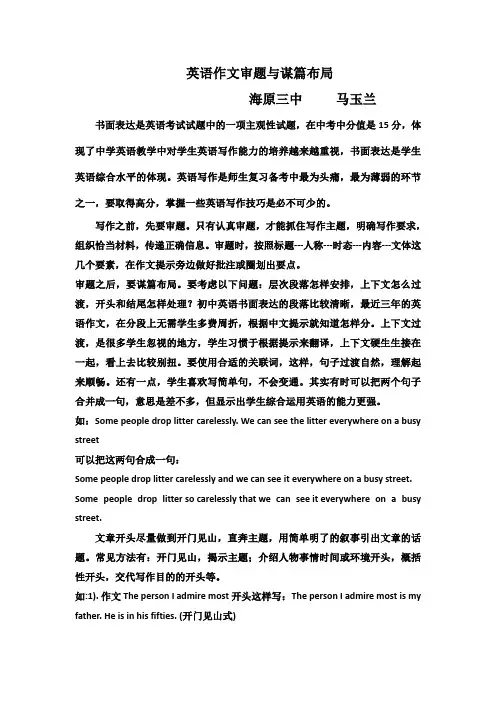
英语作文审题与谋篇布局海原三中马玉兰书面表达是英语考试试题中的一项主观性试题,在中考中分值是15分,体现了中学英语教学中对学生英语写作能力的培养越来越重视,书面表达是学生英语综合水平的体现。
英语写作是师生复习备考中最为头痛,最为薄弱的环节之一,要取得高分,掌握一些英语写作技巧是必不可少的。
写作之前,先要审题。
只有认真审题,才能抓住写作主题,明确写作要求,组织恰当材料,传递正确信息。
审题时,按照标题---人称---时态---内容---文体这几个要素,在作文提示旁边做好批注或圈划出要点。
审题之后,要谋篇布局。
要考虑以下问题:层次段落怎样安排,上下文怎么过渡,开头和结尾怎样处理?初中英语书面表达的段落比较清晰,最近三年的英语作文,在分段上无需学生多费周折,根据中文提示就知道怎样分。
上下文过渡,是很多学生忽视的地方,学生习惯于根据提示来翻译,上下文硬生生接在一起,看上去比较别扭。
要使用合适的关联词,这样,句子过渡自然,理解起来顺畅。
还有一点,学生喜欢写简单句,不会变通。
其实有时可以把两个句子合并成一句,意思是差不多,但显示出学生综合运用英语的能力更强。
如:Some people drop litter carelessly. We can see the litter everywhere on a busy street可以把这两句合成一句:Some people drop litter carelessly and we can see it everywhere on a busy street. Some people drop litter so carelessly that we can see it everywhere on a busy street.文章开头尽量做到开门见山,直奔主题,用简单明了的叙事引出文章的话题。
常见方法有:开门见山,揭示主题;介绍人物事情时间或环境开头,概括性开头,交代写作目的的开头等。
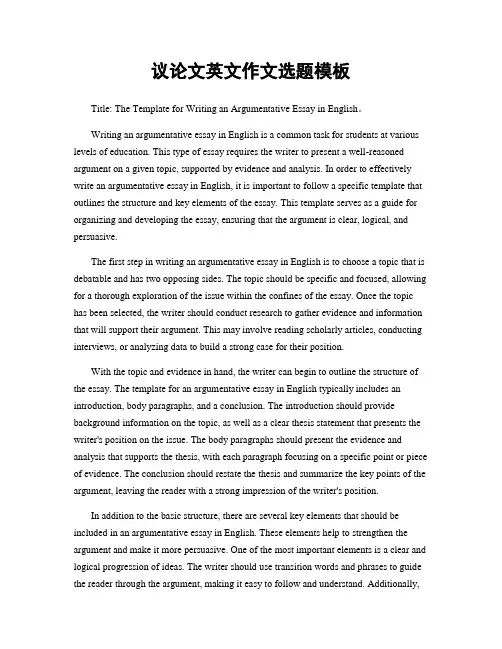
议论文英文作文选题模板Title: The Template for Writing an Argumentative Essay in English。
Writing an argumentative essay in English is a common task for students at various levels of education. This type of essay requires the writer to present a well-reasoned argument on a given topic, supported by evidence and analysis. In order to effectively write an argumentative essay in English, it is important to follow a specific template that outlines the structure and key elements of the essay. This template serves as a guide for organizing and developing the essay, ensuring that the argument is clear, logical, and persuasive.The first step in writing an argumentative essay in English is to choose a topic that is debatable and has two opposing sides. The topic should be specific and focused, allowing for a thorough exploration of the issue within the confines of the essay. Once the topic has been selected, the writer should conduct research to gather evidence and information that will support their argument. This may involve reading scholarly articles, conducting interviews, or analyzing data to build a strong case for their position.With the topic and evidence in hand, the writer can begin to outline the structure of the essay. The template for an argumentative essay in English typically includes an introduction, body paragraphs, and a conclusion. The introduction should provide background information on the topic, as well as a clear thesis statement that presents the writer's position on the issue. The body paragraphs should present the evidence and analysis that supports the thesis, with each paragraph focusing on a specific point or piece of evidence. The conclusion should restate the thesis and summarize the key points of the argument, leaving the reader with a strong impression of the writer's position.In addition to the basic structure, there are several key elements that should be included in an argumentative essay in English. These elements help to strengthen the argument and make it more persuasive. One of the most important elements is a clear and logical progression of ideas. The writer should use transition words and phrases to guide the reader through the argument, making it easy to follow and understand. Additionally,the essay should include counterarguments and refutations, addressing opposing viewpoints and demonstrating why the writer's position is stronger.Another important element of an argumentative essay in English is the use of evidence to support the argument. This evidence may take the form of statistics, examples, expert opinions, or anecdotes, and should be carefully selected to provide the strongest possible support for the writer's position. The evidence should be analyzed and explained in the essay, showing how it relates to the thesis and why it is persuasive. This analysis helps to demonstrate the writer's critical thinking skills and ability to reason through complex issues.Finally, an argumentative essay in English should be written in a clear and concise manner, with a focus on formal language and proper grammar. The writer should avoid using emotional language or personal anecdotes, instead relying on logical reasoning and evidence to make their case. The essay should also be well-organized, with each paragraph contributing to the overall argument and flowing smoothly from one to the next.In conclusion, writing an argumentative essay in English requires careful planning and attention to detail. By following a specific template that outlines the structure and key elements of the essay, writers can ensure that their arguments are clear, logical, and persuasive. With a strong thesis, well-supported evidence, and a clear and concise writing style, an argumentative essay in English can effectively present a well-reasoned argument on a given topic.。

选题原因和意义英文作文Choosing a topic is important because it determines the focus and direction of the writing. Without a clear and meaningful topic, the writing may lack coherence and fail to engage the reader.The significance of selecting a topic lies in itsability to capture the reader's attention and convey the writer's message effectively. A well-chosen topic can make the writing more interesting and relevant, leading to a more enjoyable reading experience.The process of choosing a topic allows the writer to explore different ideas and perspectives, leading to personal growth and development. It encourages critical thinking and creativity, as the writer considers various options before making a decision.A carefully selected topic can also contribute to the overall impact and effectiveness of the writing. It can setthe tone for the piece and create a strong first impression, drawing the reader in and setting the stage for what is to come.In addition, choosing a topic that is meaningful to the writer can result in a more passionate and authentic pieceof writing. When the writer is personally invested in the topic, it is more likely to resonate with the reader and leave a lasting impression.Ultimately, the act of choosing a topic is a crucial step in the writing process, as it sets the foundation for everything that follows. It is an opportunity for thewriter to make a deliberate and impactful decision thatwill shape the outcome of their work.。
英语本科毕业论文选题英语本科毕业论文选题是学生在完成本科阶段学习后,对所学知识进行综合运用和深入研究的重要环节。
选题的质量直接影响到论文的写作方向和研究深度,因此,选择一个合适的论文题目至关重要。
以下是一些建议和可能的选题方向,供英语专业本科生参考:1. 英语文学研究- 莎士比亚戏剧中的女性形象分析- 现代主义文学中的城市意象- 后殖民文学中的文化身份探讨- 浪漫主义诗歌与自然的关系2. 英语语言学研究- 英语口语中的非言语交际功能- 英语词汇习得与记忆策略- 双语教育对语言发展的影响- 英语语法教学中的难点与对策3. 翻译理论与实践- 跨文化交际中的翻译策略- 电影字幕翻译的技巧与挑战- 法律文本翻译的准确性与公正性- 文学作品翻译中的忠实度与创造性4. 英语教学法研究- 任务型语言教学法在英语课堂的应用- 多媒体技术在英语教学中的有效性分析- 英语口语教学中的互动式学习模式- 英语写作教学中的反馈机制研究5. 英语国家文化研究- 美国梦在当代美国文化中的演变- 英国社会阶层与文化身份的关联- 澳大利亚土著文化的保护与传承- 加拿大多元文化政策的实践与挑战6. 跨文化交流与国际关系- 全球化背景下的跨文化商务沟通- 英语作为国际语言在外交领域的应用- 国际旅游中的文化冲突与适应- 英语媒体在塑造国际形象中的作用7. 英语语言测试与评估- 英语水平测试中的效度与信度分析- 英语口语测试中的评分标准与公正性- 英语写作评估中的主观性与客观性- 英语听力测试中的认知策略研究选择论文题目时,学生应考虑自己的兴趣、所掌握的资料、指导教师的建议以及研究的可行性。
一个好的论文题目应当具有明确的研究目的、清晰的研究问题、合理的研究方法和可操作的研究计划。
同时,题目的表述应当简洁明了,避免过于宽泛或过于狭窄。
在确定题目后,学生应进行充分的文献综述,以确保研究的创新性和学术价值。
英语论文如何选题(模版)第一篇:英语论文如何选题(模版)英语论文如何选题论文作为学科科研成果的主要形式, 既能反映出该项成果的价值和功效, 又能反映出作者的科研水平和能力, 是衡量作者学术水平高低的重要标志, 英语论文同样如此。
而选题是撰写论文的第一步, 选择课题的恰当与否, 常常关系到整个研究的成功与否。
在广大教研人员和教师的写作实践中, 常常会碰到一些论文由于选题的失当而无法继续的情况,可见选题的重要性。
一、选题的重要性选题是论文所要重点论述的事项或解答的问题。
是撰写论文的第一步, 也是关键的一步, 决定着论文的价值, 也关系着学术研究的成败。
正确选题的重要性主要表现在以下几个方面:(一)选题的方向正确与否直接影响到论文撰写能否顺利进行, 完成质量如何, 甚至对于我们今后所要钻研的学科领域的进一步发展也会有很大的影响。
正确恰当的选题可以保证写作的顺利进行, 可避免南辕北辙的错误。
(二)选题主要解决了论文写什么的问题, 正确的选题确定了论文的撰写目标和范围, 因此可以使我们在一定的范围内收集材料, 整理材料, 以避免无目的无范围的盲目阅读与研究, 可以避免时间和精力的浪费, 并能在有限的时间内高效率地完成高质量的论文。
(三)选题直接影响论文的质量。
选题不好、不恰当会浪费时间和精力, 影响撰写的速度, 还有可能会使论文的撰写走入死胡同, 无法继续进行下去, 最终只能草草了事, 写出的论文质量不可能高。
甚至很有可能使教师无法顺利完成论文。
反之, 恰当的选题则为写出高质量的论文打下良好的基础。
(四)选题有利于提高研究能力。
选题是研究工作实践的第一步, 选题需要积极思考, 需要具备一定的研究能力, 在开始选题到确定题目的过程中, 需要钻研专业知识, 慢慢学会收集、整理、查阅资料等研究工作的方法, 并要对已学的专业知识反复认真地思考, 然后从某一层面或某一角度深化对问题的认识。
从而使从事学术研究的各种能力得到初步的锻炼提高。
大学英语毕业论文选题过程与写作文档2篇Selection process and writing documents of College English graduation thesis编订:JinTai College大学英语毕业论文选题过程与写作文档2篇前言:毕业论文是普通中等专业学校、高等专科学校、本科院校、高等教育自学考试本科及研究生学历专业教育学业的最后一个环节,为对本专业学生集中进行科学研究训练而要求学生在毕业前总结性独立作业、撰写的论文。
本文档根据毕业论文内容要求和特点展开说明,具有实践指导意义,便于学习和使用,本文下载后内容可随意调整修改及打印。
本文简要目录如下:【下载该文档后使用Word打开,按住键盘Ctrl键且鼠标单击目录内容即可跳转到对应篇章】1、篇章1:大学英语毕业论文选题过程与写作文档2、篇章2:熟悉毕业论文怎样选题文档篇章1:大学英语毕业论文选题过程与写作文档本文是英语毕业论文选题过程与写作标题是英语毕业论文的不可分隔的重要部分。
论文标题要使读者愿意选读该论文;它或者明说或者暗示论文的内容,而且为论文确定基调。
没有标题的论文是不完整的论文。
确定了论文标题后,我们就要写毕业论文摘要了。
因有很多学生不知如何写英语毕业论文摘要。
对此笔者要较详细予以论述。
2.英文毕业论文摘要各部分的写作根据《ei》对英文摘要的写作要求,英文摘要的写作并没有一成不变的格式,但一般来说,英文摘要是对原始文献不加诠释或评论的准确而简短的概括并要求它能反映原始文献的主要信息。
2.1.英语毕业论文——目的(what i want to do?)目的。
主要说明作者写作此文的目的,或本文主要解决的问题。
一般来说,一篇好的英文摘要,一开头就应该把作者本文的目的或要解决的主要问题非常明确地交待清楚。
必要时,可利用论文中所列的最新文献,简要介绍前人的工作,但这种介绍一定要极其简练。
在这方面,《ei》提出了两点具体要求:2.1.1) eliminate or minimize background information(不谈或尽量少谈背景信息)。
大学英语毕业论文选题及写作文档2篇Topic selection and writing documents of College English graduation thesis编订:JinTai College大学英语毕业论文选题及写作文档2篇前言:毕业论文是普通中等专业学校、高等专科学校、本科院校、高等教育自学考试本科及研究生学历专业教育学业的最后一个环节,为对本专业学生集中进行科学研究训练而要求学生在毕业前总结性独立作业、撰写的论文。
本文档根据毕业论文内容要求和特点展开说明,具有实践指导意义,便于学习和使用,本文下载后内容可随意调整修改及打印。
本文简要目录如下:【下载该文档后使用Word打开,按住键盘Ctrl键且鼠标单击目录内容即可跳转到对应篇章】1、篇章1:大学英语毕业论文选题及写作文档2、篇章2:大学毕业论文选题依据文档篇章1:大学英语毕业论文选题及写作文档以下是英语毕业论文选题及写作撰写英语毕业论文是每个xxx大学大学生离开校园,走向工作岗位之前必须完成的一项任务。
此项任务完成得好坏,顺利与否直接关系到毕业生的按期毕业问题。
毕业论文也是对学生进行综合实践训练,培养学生科学研究能力和创新能力,提高学生综合素质的重要环节。
因此,笔者认为有必要向学生介绍一些写英语毕业论文的技巧,以便他们能顺利完成此项任务。
本文虽然主要介绍如何写英语毕业论文,但从写论文的步骤、方法等方面来看对其他专业的学生也有一定的可借鉴之处。
撰写英语毕业论文主要分以下几个阶段:准备、撰写提纲、第一稿、第二稿、第三稿、定稿与答辩。
i. 英语毕业论文准备学生可以根据本专业教学大纲选定研究范围(英语教育、文学、翻译及外贸等),英语毕业论文选题应符合下列要求:1.结合专业特点,符合专业培养目标的要求。
2.尽可能与社会实践实际相结合。
3.题目的难度和分量要适当。
在这个阶段学生们遇到的主要问题是如何限定课题范围。
最好是课题已在学生脑子里酝酿了好长时间,并且他现在急于将他的思想观点诉诸纸上,与他人分享;最差的是课题由导师布置给他。
英语系毕业论文选题英语系毕业论文选题是英语专业学生在完成本科或研究生学业前的一项重要学术任务。
它不仅考验学生对英语语言、文学、文化、翻译、语言学等领域的掌握程度,也是对学生独立研究能力和学术写作能力的一次全面检验。
以下是一些可能的选题,供英语系学生参考:1. 英语文学方向- 莎士比亚戏剧中的女性形象分析- 现代主义文学中的都市主题研究- 后殖民文学中的文化身份建构- 英国浪漫主义诗歌与自然的关系- 美国黑人文学中的种族与社会正义2. 英语语言学方向- 英语口语中的语码转换现象研究- 英语词汇习得与记忆策略- 英语语法教学方法的比较分析- 跨文化交际中的语言障碍与解决策略- 英语作为第二语言的语音教学研究3. 翻译学方向- 翻译中的文化差异与适应性策略- 机器翻译与人工翻译的比较研究- 翻译实践中的语义转换问题- 电影字幕翻译中的文化传递- 法律文本翻译的准确性与法律效力4. 英语教育方向- 英语教学中的互动式学习模式- 多媒体技术在英语教学中的应用- 英语作为外语的写作教学策略- 跨文化能力在英语教学中的重要性- 英语教师专业发展与终身学习5. 英语国家文化研究- 美国流行文化对全球文化的影响- 英国社会阶层与文化身份的变迁- 澳大利亚土著文化的保护与传承- 加拿大多元文化政策的实践与挑战- 英语国家节日庆典的文化意义选择毕业论文的题目时,学生应考虑自己的兴趣、研究背景、可获得的资源和指导教师的建议。
一个好的选题应该具有明确的研究目的、清晰的研究问题、可行的研究方法和一定的学术价值。
同时,选题应具有一定的新颖性,能够为学术界或实践领域提供新的见解或解决方案。
英语专业毕业论文可选题目参考范文英语专业毕业论文可选题目参考一一、翻译类毕业论文选题1.Study on Translation of Trade Marks and Culture商标翻译与文化研究2.The Social and Cultural Factors in Translation Practice影响翻译实践的社会和文化因素3.On the Translation of English Idioms论英语习语的翻译4.Study on Features and Translation of English Idioms英语习语翻译特点研究5.The Comparison and Translation of Chinese and English Idioms中英习语翻译与比较6.Study on Loyalty in English-Chinese Translation中英互译的忠实性研究7.Cultural Equivalence in Translation翻译中的文化对等性研究8.Literature Translation and the Important of it文学翻译与重要性研究9.On the Du Fu’s Poems Translation论杜甫的诗词翻译10.The Analysis of Techniques for Learning a Foreign Language Through Translation 通过翻译学习外语的技巧分析11.Cultural Differences and Translation in Chinese and English Color words中英颜色词的文化差异及翻译12.An Cultural Perspective on Untranslatability翻译中不可译性的文化阐释13.Cultural Connotation and Translation in Chinese and English Animals中英动物文化内涵的不同及翻译14.On Degree of Translator's Subjectivity in Translation浅论翻译中的译者主体性发挥的度15.A Probe of the Effect of Rhetorical Devices in English Advertisement修辞策略在广告英语中的效用探究16.Error Analysis of the English Translation of the Information about Scenic Spots in Wuhan 武汉旅游景点资料的英译错误分析17.Semantic--Transliteration-the Most Favorable Method for Translating Foreign Words into Chinese 音意兼译—外来词中译之首选方法18.A Tentative Study on the Cohesion and Coherence in Sun Zhili’s Chinese Translation of Pride and Prejudice 浅论《傲慢与偏见》孙致礼中译本的衔接与连贯19.Chinese Translation of Attributive Clauses in English for Science and Technology 科技英语中定语从句的汉译20.Film Titles and Their Translation——A cross-cultural perspective从跨文化角度分析电影片名及其翻译21.Translating Expressions on Public Signs from Chinese into English 汉语公示语英译22.Cultural differences and translation论文化差异与翻译23.The Translation Principle of Brand Names and Brand Culture商标名的翻译原则与品牌文化24.On Translation of English Film Names英文电影片名的翻译策略与翻译方法研究25.意美、音美、形美--英文商标的汉译Beauty in Sense, Sound and Form--On Translation of English Trademarks into Chinese26.中文商标英译探On the Translation of Trademarks from Chinese into English二、文化类毕业论文选题27.国际商务谈判中的双赢语用策略The Win-Win PragmaticStrategies in International Business Negotiation28.Grice 的合作原则在国际商务谈判中的应用The Application of Grice’s Cooperation Principle in International Business Negotiation29.中西文化面子观差异对比分析An Analysis on Differences between Chinese and WesternIdeas on Face30.中西文化中女性角色意识差异及其对职业发展影响Differences between Chinese and Western Role Awareness of Women and the Effects on Their Career Development 31.英语学习中文化障碍Cultural Obstacles in English Learning32.从中西委婉语的对比透视中西文化差异Understand Chinese and English Cultural Differences through the Comparison between Chinese and western Euphenism 33.中英禁忌语比较A Comparison between Chinese and English taboos34.从隐私权看中西文化差异A Comparison between Chinese and Western Cultural Differences from the Aspect of Privacy right 35.中西社会习俗比较A Comparison Between Chinese and Western Social Conventions 36.言语行为理论及其应用Speech Act and its Application37.湖北经济学院英语自主学习现状调查A Survey on the Students’ English Autonomous Learning in Hube i University of Economics38.湖北经济学院双语课程学习现状调查A Survey on Bilingual Courses’ Learning in Hubei University of Economics39.The Cultural Connotation of English Etymology and the Teaching of English V ocabulary 英语词源的文化内涵与词汇教学40.English idioms—A Mirror Reflecting British Culture 英语习语与英国文化反映41.On Values of Chinese from Perspective ofLexicon从词汇角度读中国人的价值观42On Cultural Differences of Body Language between English and Chinese论中英体态语文化差异43.The Analysis on the Differences of Interpersonal Relationship between Eastern and Western People 东西方人际关系要素差异探析44.Approach to Cultural Differences in Sino-U.S. Business Negotiation and its Impacts 中美商务谈判中的文化差异及其影响探析45.Asymmetrical Features of Politeness Principle in Cross-cultural Communication 跨文化交际中的礼貌原则的非对称性研究46.English and Chinese Euphemisms: A Comparison between Their Cultural Implications 从英汉委婉语对比中透析中西文化差异47.On the Cultural Differences of the Etiquette Norms in Chinese and English Nonverbal Communication 中英非语言交际礼俗规范的文化差异研究48.A Comparative Study on the Different Cultural Connotations of Basic Chinese andEnglish Color Words 英汉基本颜色词文化内涵对比研究49.Characteristic and Cultural Differences of the English and Chinese Idioms 中英文习语的特点以及文化差异50.Chinese and Western Culture Values in Advertising Language从广告语中看中西方文化观51.The Differences of Family Values between China and American中国和美国家庭观差异52.The Comparison of Chinese and Western Interpersonal Relationships中西人际关系比较53.Cultural Difference Between Chinese and English on Politeness从中英文礼貌用语中看文化差异54.谈跨文化交际中的“面子”观On Face Perception in Cross-cultural Communication55.委婉语在跨文化交际中的应用The Application of Euphemism in Cross-cultural Communication56.从英汉习语看东西方文化异同Differences and Similarities between Eastern and Western Cultures in Chinese and English Idioms57.中英文化中的礼貌对比研究 A Contrastive Study of Politeness in English and Chinese Cultures58.解析文化差异引起的语用失误The Study of Pragmatic Failure: From the Perspective of Cultural Differences59.从文化角度论英汉语中的性别歧视On the Sexism in Chinese and English from the Cultural Perspective60.中美商务谈判中的文化因素探析Approach to Cultural Factors for the Sino-American Business Negotiation61.英汉道歉语的对比研究A contrastive study of apologies in English and Chinese62.跨文化交际中颜色词的运用Application of colors in intercultural communication63.英汉寒暄语的差异研究Some difference of small talks between Chinese and English 64.不同交际风格中恭维语及其回应的研究Compliment and its response with different communication styles65.英汉动物词汇文化内涵意义对比研究The cultural connotations of animals in Chinese and English66.英语委婉语的功能与效果研究On functions and effects of euphemism in English67.中外幽默的跨文化对比 A intercultural comparison between Chinese and foreign humor 68.英语副语言交际研究A survey on communication of paralanguage三、语言类毕业论文选题69.语篇分析中的语境功能研究The function of context indiscourse analysis70.语篇分析在英语阅读教学中的运用研究Discourse analysis in the application of teaching English reading71.英语广告语言特点分析An analysis on the feature of English advertisement72.非语言交际与身势语研究Nov-verbal communication and gesture language73.英语委婉语研究About English euphemism74.On Puns in English Advertisements—from the Perspective of Relevance Theory 从关联理论看英语广告双关语75.(My) Dialects and its Negative Effect upon English Pronunciation Learning (本人)方言及其对英语语音学习的负面影响76.A Comparative Study of Euphemisms in English and Chinese英汉委婉语对比研究77.A Study of Sexism in the English Language英语语言中的性别歧视研究78.Thematic Theory and Its implications to English Writing 主位理论及其对英语写作的启示79.英语拒绝方式研究Research on the Ways of Rejection in English80.论中美广告中所反映的文化价值观On the Cultural Values in the Advertisements of China and US81.从历史文化的发展看某个英语词或短语的语义演变Semantic Evolution of A Word or Phrase from the Perspective of History 82.社会不平等现象在美国英语中的反映The Reflection of Social Inequality in American English83.英语财经报道的语言特点Language Features of English Financial Report四、英语教育类毕业论文选题84.Body Language in English Teaching英语教学中的身体语言研究85.The Diversification of English Language Teaching英语教学多样性研究86.The Present Situation of Bilingual Education in China中国双语教学现状研究87.Culture and English Teaching文化与英语教学88.Consideration on Bilingual Teaching双语教学的思考89.The English Teaching Based on Multimedia基于多媒体的英语教学90.Cultural Difference and English T eaching文化差异与英语教学91.Cross-cultural Communication and English Teaching跨文化交际与英语教学92.Some Designs on English Learning in school93.中学英语教学设计The Contrast of Middle School Education between China & West 94.中西方中学教育对比研究The Practice of English Class Teaching95.英语课堂教学实践96.English Classroom Teaching: Teacher-dominant or Student-centered英语课堂教学——教师主宰还是学生中心97.Personality Factors to the Success of Foreign Language Learning个性因素在外语学习中的作用98.The Application of Communicative Approach Techniques in English Learning 交际法手段在英语学习中的运用99.On the Reading Strategies of English as a Foreign language谈英语的阅读策略100.Cultural influence on English Reading论文化背景知识在英语阅读中的作用101.On basic qualities of a successful English teacher论英语教师的基本素质102.On the principle of adhering to student-centred teaching论以学生为中心的教学原则103. On the principle of combining restriction and utilization of native language in foreign language teaching论在外语教学中控制和利用母语的原则104. Applying the Communicative Approach in the middle school English teaching 交际法在中学英语教学的运用105. Cultivating students’ reading skills in English text teaching in middle school 在中学英语课文教学中培养学生的阅读技巧106. Analysis of Factors Influencing College Student on Autonomous English Learning 影响大学生英语自主学习的因素分析107. Evaluation of Autonomous English Learning自主英语学习的质量评估108. Application of Internet and Multi-media in English Teaching网络多媒体在英语教学中的应用109. A Survey Research on Relevance between English vocabulary and reading ability 词汇量与英语阅读能力的相关性调查研究110. A Survey of using College English Network Platform大学英语网络学习平台使用情况调查研究111. The Effect of Conceptual Metaphor Theory on the English Vocabulary Acquisition of Chinese Senior High School Students 概念隐喻理论对中国高中生英语词汇习得的影响112. Negative Transfer of Native Language in Chinese Senior High School Students' EFL Writing and Its Implications to the English Language Teaching中国高中生英语写作中的母语负迁移及其对英语教学的启示113. On Developing Communicative Competence in Teaching English to Chinese High School Students 论中国中学英语教学中学生交际能力的培养114. An Investigation of Vocabulary Learning Strategies Taken by Chinese Senior High School Students中国高中生英语词汇学习策略调查115. An Investigation of the English Learning Motivation of Three-year College Students and Its Implications for English Language Teaching大专生英语学习动机调查研究及其对英语教学的启示116. 经济院校非英语专业学生自主学习态度调查研究A Survey on the Attitude towards Learner Autonomy of Non-English Majors in the University of Economics117. 大学生使用英语多媒体学习光盘现状的调查研究A Survey on the Use of Multimedia Learning CD by College Non-English Majors118. 论多媒体辅助英语教学环境下教师、教材和学生的角色与作用On the Role and Functions of Teachers, Teaching Materials and Learners in the Multimedia-aided EnglishClassroom119. 语用推理对英语听力理解的影响The Effect on English Listening Comprehension from Pragmatic Interference 120. 论阅读理解教学中学习者写作能力的培养On the Cultivating of Learner’s Writing Competence in Teaching Reading五、英语文学类毕业论文选题121. The Independent Spirit of Hester Brynne in The Scarlet Letter《红字》中海丝特。
英语论文选题与谋篇词汇的广度,深度及强度知识在阅读理解中的作用研究学生姓名\专业\学号任课老师姓名/职称1.课题来源(研究背景)词汇是语言的基石。
无论在一语还是二语的学习中,都离不开对词汇的学习。
但是,二语词汇习得及其相关领域的研究在较长时间内却受到了相对的冷落。
幸运的是自上个世纪90年代以来,二语词汇习得研究引起了研究者们越来越多的兴趣。
(Coady & Huckin, 2001)。
研究范围涉及到词汇量评估、词汇知识、词汇知识的发展、词汇知识的测试、心理词库以及词汇习得策略等方面。
近10多年来,对二语词汇知识的理论探讨和实证研究更是成为了词汇研究的一个新走向。
2.国内外研究现状及水平由于词汇知识是一个极其庞杂的知识体系,到目前为止,对于词汇知识的本质还没有达成一个统一的、毫无争议的共识。
关于词汇知识的概念和内涵,二语词汇研究者提出了各不相同却又互补的理论框架。
(Richards,1976;Nation,1990;Wesche&Paribakht,1996;Chappelle,1998;引自Qian 2002)。
但大多数研究者认为词汇知识不是单维的,而是复杂、多维的。
Henriksen (1999)提出了词汇知识应包括三个维度:(1)部分词汇知识和精确词汇知识;(2)词汇知识深度(depth);(3)接受性(receptive)词汇知识和产出性(productive)词汇知识。
第一个维度将词汇知识水平视作为等同于词汇理解的水平,即词汇知识的广度;第二维度中的词汇知识深度连续体包括词的知识和词的组合关系和聚合关系,也就是说二语学习者的词汇知识系统是如何组织和构成的;前两个维度是与词的知识相关的连续体,而第三个维度则是一个控制连续体,反映学习者对词汇的存取和应用的熟练程度。
词汇知识的广度指的就是学习者拥有的词汇量的多少。
这是研究者们研究最多的一个方面。
对词汇知识的广度进行测试研究的有Meara(1992), Nation( 1983, 1990, 2007), Schmitt(1993, 2001), Laufer&Nation(1999) 等。
Read (2004)指出Nation的“英语词汇水平测试题(V ocabulary Levels Test, 简称VLT)是最出名的广度测试工具,影响最大。
词汇水平测试属于接受性测试,它不能提供目标词汇的产出运用的情况,而且它只衡量目标词多个意思中最常见的意义。
词汇知识的深度则被定义为“对词汇知识了解的质量,或指学习者对一个词了解的程度”(Read,1993)。
Richards(1976)最先提出掌握一个词,需要掌握不同方面的词汇知识,并就此提出八个假设。
此后,Nation(1990)也指出真正了解一个词仅仅知道它在特定背景下的某一意思是不够的,而是要了解与该词有关的各种知识,从它的发音、拼写、语域、风格和形态学上的特征到与其他词的句法和语义关系,包括内涵意义、反义、同义和上下义等关系。
到目前为止,Nation的词汇知识框架被研究者普遍接受,被认为是最完美的框架。
但是,这些词汇知识并不意味着能全部被掌握。
实际上,就大多数词来说,本族语者也只能掌握其中几个方面的知识。
尤其是一些低频词,本族语者也只是掌握其中的接受性知识,而不能掌握产出性知识。
Read(1993,1995,1998),Schmitt&Meara(1997),Schmitt(1998),Qian(1999,2002),和Qian&Schedle (2004)都对词汇知识的深度测试做了研究。
其中较有影响的是Read的word associate test。
但是word associate test 测量的主要是搭配方面的知识,包括聚合和组合关系方面的知识。
对词的多义现象及词的形态变化如派生词等均无涉及。
当然要在一个测试中穷尽测量词汇知识的各个方面,是不可能也不可行的,除非只选择少量的高频词进行测量(如刘绍龙,2006)。
但新的词汇深度测试还是应尽可能准确而全面的衡量学习者所掌握的词汇知识。
除了广度和深度,积极/消极(接受性/产出性)词汇知识也被研究者们认为是一个重要维度。
也还有回忆性知识和识别知识等提法。
但在过去的研究中研究者互用这些概念,并未对此进行严格界定,造成了一定的混淆。
(Laufer, !998)Waring (1997)提出,要证明一个词的接受性知识,受试必须要能提供英语单词对应的一语翻译。
而要证明产出性知识,受试要能为一语单词提供对应的英语单词。
在此基础上,Laufer(2004)采纳积极\消极,回忆\识别两个两分法,对受试者所掌握的词汇知识程度进行界定,提出“词汇知识的强度”的概念。
她提出:能提取词的形式的人和不能提取词的形式但能提取意义的人所掌握的知识存在差异。
前一种知识为积极知识,后一种则是被动知识。
同样地,能回忆出词的形式和意义与不能回忆但能认知这些形式或意义之间也存在差异。
因此,她提出了词汇知识的强度的四个样态:积极回忆(active recall),消极回忆(passive recall),积极识别(active recognition ),消极识别(passive recognition)。
关于词汇知识的强度测试研究较少,仅有2004年Laufer&Cathie Elder等进行的单语版以及Laufer&Goldstein进行的双语(英语和希伯来语)版的词汇广度结合强度的机测。
他们的研究结果证明了词汇强度的四个层次都形成难度层次,统计学上具有显著意义。
并且提出为了更好地了解学习者词汇知识掌握的程度,需要单独的对词汇量和词汇强度进行测试。
国内研究者对词汇知识的广度进行测试的较多,如桂诗春、喻爱菊、周大军、邓昭春、邵华、吕长立以及解放军外国语学院英语测试中心等。
这些研究以不同的被试和方式对词汇量以及词汇量与语言能力的关系进行了调查。
近几年来,有分别对词汇知识的广度和深度进行测试的,如黄强(2002),李俊(2002),黄小萍(2003),白丽梅(2004),李争艳(2004)等,他们采用不同的测量方法,调查词汇广度、词汇深度知识的发展特点,与学习者综合语言能力或某一项技能的相关性。
对词汇知识的强度进行测试研究的目前只有张艳(2007),她还探讨了词汇知识强度的各层面与学习者英语综合能力的关系。
研究者在关注词汇知识的广度、深度及强度的测量时,也注重研究词汇知识的各个维度与综合语言能力或听、说、读、写单项技能的关系。
词汇在阅读中所起的重要作用是毋庸置疑的,但对词汇知识与阅读理解能力的本质关系却并无定论。
在一语研究中,词汇知识与阅读关系的研究受到重视,有很多的相关分析和实验来证明。
大多数的研究结果表明,词汇知识与阅读理解的相关关系从0.3-0.8不等。
这些不同的研究结果受测试工具、词汇知识测试的范围、维度、受试者的年龄的影响。
而在二语研究中,对于词汇知识与阅读理解的关系,国内外的研究大部分集中于如何通过阅读来习得词汇,只有较少的研究涉及词汇在阅读中的作用。
国外的研究者Debot, Paribakht&Wesche(1997)和Qian(1999;一、课题的来源、研究的目的意义(包括在我国应用的前景)、国内外研究现状及水平。
3.研究目的及意义综上所述,我们可以看出目前对该课题的研究取得了一定的成果,但由于受测试理论及测试工具种种因素的限制,这些研究尚未完全揭示词汇知识与阅读理解关系的本质。
因此,本文拟在他们研究的基础上,从词汇知识的广度、深度、及强度三个维度入手,试图更全面、更深入地测量学习者的词汇知识,并着重探讨这三个维度在英语学习者阅读理解中所起的作用。
该研究将采用实证的方法,详细揭示学习者的二语词汇知识的全貌,并揭示其在阅读中所起的重要作用。
本研究所采用的多维度的词汇知识测试法既可以应用到诊断性词汇测试中,也可以为分级阅读教学提供依据。
研究结论也将对词汇教学与阅读教学有所启示。
4.研究的主要内容与论文框架:本研究将采用实证的方法,从词汇知识的广度,深度,强度三个维度来探讨在外语环境中中国非英语专业二年级学生的词汇知识对阅读理解能力的影响。
通过该研究,笔者试图回答以下问题:(1)词汇知识的广度和深度以及它们与强度的四个样态之间是否存在显著相关关系?(2)词汇知识的广度,深度和强度的四个样态与阅读理解之间是否存在显著相关关系?(3)词汇知识的三个维度各自能在多大程度上预测学习者的阅读理解能力?论文的大致框架如下:Chapter 1 Introduction1.1Research Background and Significance1.2Research questions1.3 Organization of the studyChapter 2 Theoretical Framework2.1 What Counts as V ocabulary Knowledge2.2 Henrikesn’s three dimension approach2.3 Four Views on the Relationship between Reading and V ocabulary Knowledge Chapter 3 Literature Review3.1 Investigations on V ocabulary Breadth3.2 Studies on V ocabulary Depth3.3 Research on V ocabulary Strength3.4 Research on the Correlation Between V ocabulary Breadth, Depth and Strength 3.5 Research on the Correlation Between V ocabulary Knowledge and ReadingProficiencyChapter 4 Design of The Present Study4.1 Purpose4.2 Subjects4.3 Instruments for Data Collection4.3.1 V ocabulary Levels Test4.3.2 Depth Test of V ocabulary Knowledge4.3.3 V ocabulary Strength Test4.3.4 Reading Comprehension Test4.4 Procedures of Data Collection4.5 Tools for Statistical AnalysisChapter 5 Data Analysis and Discussion5.1 Results5.2 Discussion5.2.1 Correlation Between V ocabulary Size, V ocabulary Depth and V ocabulary Strength5.2.2 Correlation between The three Dimensions of V ocabulary knowledge and Reading Proficiency5.2.3 To What Extent can the three dimensions Predict Reading Proficiency Chapter 6 Conclusion6.1 Summary of the research6.2 Pedagogical Implications6.3 Limitations and Future Orientations5.研究方案及措施本研究将选取广西师范大学非英语专业二年级两个自然班的学生为受试,对其进行4次测试。